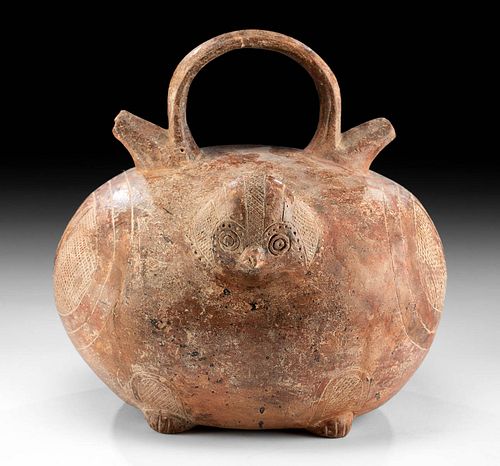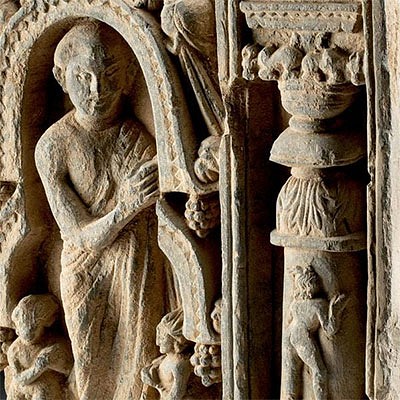Calima Ilama Pottery Stirrup Offering Jar w/ Dove
Lot 220
About Seller
Artemis Gallery
686 S Taylor Ave, Ste 106
Louisville, CO 80027
United States
Selling antiquities, ancient and ethnographic art online since 1993, Artemis Gallery specializes in Classical Antiquities (Egyptian, Greek, Roman, Near Eastern), Asian, Pre-Columbian, African / Tribal / Oceanographic art. Our extensive inventory includes pottery, stone, metal, wood, glass and textil...Read more
Categories
Estimate:
$1,000 - $1,500
Absentee vs Live bid
Two ways to bid:
- Leave a max absentee bid and the platform will bid on your behalf up to your maximum bid during the live auction.
- Bid live during the auction and your bids will be submitted real-time to the auctioneer.
Bid Increments
| Price | Bid Increment |
|---|---|
| $0 | $25 |
| $300 | $50 |
| $1,000 | $100 |
| $2,000 | $250 |
| $5,000 | $500 |
| $10,000 | $1,000 |
| $20,000 | $2,500 |
| $50,000 | $5,000 |
| $100,000 | $10,000 |
| $200,000 | $20,000 |
About Auction
By Artemis Gallery
Sep 16, 2021
Set Reminder
2021-09-16 10:00:00
2021-09-16 10:00:00
America/New_York
Bidsquare
Bidsquare : Ancient & Ethnographic Art Through The Ages
https://www.bidsquare.com/auctions/artemis-gallery/ancient-ethnographic-art-through-the-ages-7473
Ancient art from Egypt, Greece, Italy and the Near East, as well as Asian, Fossils, Pre-Columbian, Native American, African / Tribal / Oceanic, Fine art, and much more! All categories, all price ranges... all legally acquired and guaranteed to be as described or your money back. Artemis Gallery info@artemisgallery.com
Ancient art from Egypt, Greece, Italy and the Near East, as well as Asian, Fossils, Pre-Columbian, Native American, African / Tribal / Oceanic, Fine art, and much more! All categories, all price ranges... all legally acquired and guaranteed to be as described or your money back. Artemis Gallery info@artemisgallery.com
- Lot Description
Pre-Columbian, Colombia, Valle Del Cauca, Calima culture, Ilama Phase, ca. 400 BCE to 200 CE. A hand-built redware pottery stirrup vessel of a bulbous form depicting an abstract avian dove. The vessel presents with a concave base, a slightly compressed spherical body with a gently sloped shoulder, and a pair of attenuated spouts flanking the terminals of a stirrup-shaped handle. The portly dove exhibits a protruding head with bullseye motif eyes and a curved beak, enormous teardrop-shaped wings incised on the sides, and a perky, panel-shaped tail on the verso. Densely incised panels of crosshatch motifs create a 'feathered' presentation on the body, wings, tail, and face and imbue the bird with its characteristic avian form. Scholars posit that, through overland and riverine trade, early Calima artisans were influenced by Ecuador's Chorrera and Jamacoaque cultures as evidenced by the double-spouted alcarraza forms, incised motifs, and other genres of pottery vessels. Size: 9" Diameter x 8.75" H (22.9 cm x 22.2 cm)
Provenance: ex-Wilcox collection, Aurora, Colorado, USA, acquired in 1994; ex-Artemis Gallery (Apolonia/Kevin Cheek)
All items legal to buy/sell under U.S. Statute covering cultural patrimony Code 2600, CHAPTER 14, and are guaranteed to be as described or your money back.
A Certificate of Authenticity will accompany all winning bids.
PLEASE NOTE: Due to recent increases of shipments being seized by Australian & German customs (even for items with pre-UNESCO provenance), we will no longer ship most antiquities and ancient Chinese art to Australia & Germany. For categories of items that are acceptable to ship to Australia or Germany, please contact us directly or work with your local customs brokerage firm.
Display stands not described as included/custom in the item description are for photography purposes only and will not be included with the item upon shipping.
#167012Repaired from over 2 dozen large and small pieces, with restoration along a few areas of base, body, and handle, and resurfacing with overpainting along new material and break lines. Minor abrasions and nicks to handle, spouts, body, head, tail, and base, with softening to some incised details, and light encrustations. Great preservation to surface coloration and overall avian form.Condition
- Shipping Info
-
All shipping is handled in-house for your convenience. Your invoice from Artemis Gallery will include shipping calculation instructions. If in doubt, please inquire BEFORE bidding for estimated shipping costs for individual items.
-
- Buyer's Premium



 EUR
EUR CAD
CAD AUD
AUD GBP
GBP MXN
MXN HKD
HKD CNY
CNY MYR
MYR SEK
SEK SGD
SGD CHF
CHF THB
THB














